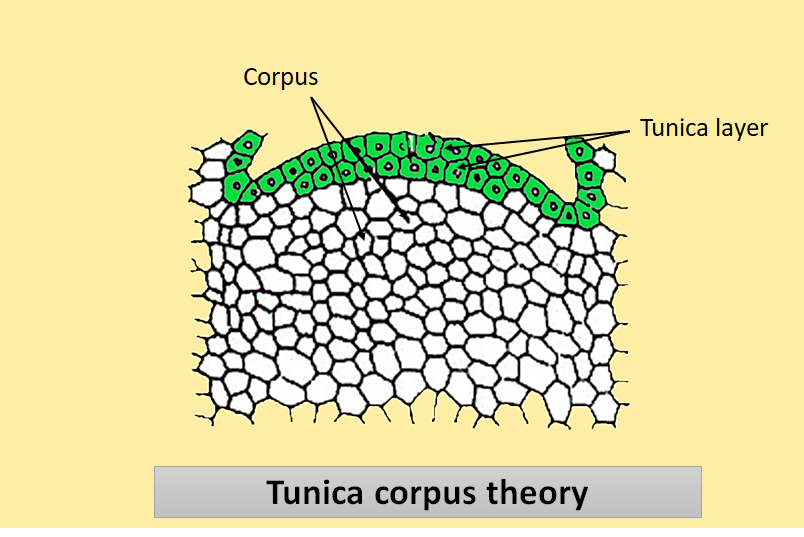
Tunica corpus theory was proposed by
(a)Schmidt
(b)Strasburger
(c)Nageli
(d)Hofmeister
Answer
575.4k+ views
Hint: Tunica corpus theory of shoot apical meristem is observed in the angiosperm only. Cryptograms and a larger number of gymnosperms do not show tunica corpus arrangement.
Complete answer:
The Tunica corpus theory was proposed by ‘Schmidt’ in 1924. This theory is relevant only to shoot apex. It is based on the plane of division of cells. According to this theory, the shoot apex consists of two distinct layers, namely, Tunica and Corpus. The shoot apex is composed of two layers of cells of tunica and corpus.
-Tunica: It is single-layered and creates epidermis. The cells of tunica are smaller as compared to corpus and divided by anticlinal divisions mostly.
-Corpus: It represents the central core with larger cells. The cells divide into all planes (anticlinal and periclinal).
Additional information:
Tunica forms a protoderm which gives rise to the sterna and leaves the epidermis. Corpus is the inner mass that splits to create procambium and terrestrial meristem. Sometimes, tunica is multilayered, and then only the outer layer builds the epidermis and the leftover layers with a corpus from the cortex of the shoot.
The plasmodesmata link remains between the cells of tunica and corpus. It is of the view that plasmodesmata command the gene expression that leads to the development of protoderm, ground meristem, and provascular tissue.
Merits of Tunica Corpus theory:
-It deals with one thing i.e. planes of cell division. As a result, the explanation of the meristem becomes correct.
-It has topographical value in the studies of the development of different tissue systems in plants.
-The destiny of the derivatives of the corpus is not predetermined.
-The derivatives of the zones are not rigid like histogen theory.

So, the correct answer is ‘Schmidt’.
Note: Tunica is characterized in having an anticlinal plane of cell divisions, i.e., the division wall is laid down perpendicular to the surface. This division reflects the surface growth in the apex. Corpus shows both the divisions. Periclinal divisions are the ones that take place parallel to a tissue or surface of an organ.
Complete answer:
The Tunica corpus theory was proposed by ‘Schmidt’ in 1924. This theory is relevant only to shoot apex. It is based on the plane of division of cells. According to this theory, the shoot apex consists of two distinct layers, namely, Tunica and Corpus. The shoot apex is composed of two layers of cells of tunica and corpus.
-Tunica: It is single-layered and creates epidermis. The cells of tunica are smaller as compared to corpus and divided by anticlinal divisions mostly.
-Corpus: It represents the central core with larger cells. The cells divide into all planes (anticlinal and periclinal).
Additional information:
Tunica forms a protoderm which gives rise to the sterna and leaves the epidermis. Corpus is the inner mass that splits to create procambium and terrestrial meristem. Sometimes, tunica is multilayered, and then only the outer layer builds the epidermis and the leftover layers with a corpus from the cortex of the shoot.
The plasmodesmata link remains between the cells of tunica and corpus. It is of the view that plasmodesmata command the gene expression that leads to the development of protoderm, ground meristem, and provascular tissue.
Merits of Tunica Corpus theory:
-It deals with one thing i.e. planes of cell division. As a result, the explanation of the meristem becomes correct.
-It has topographical value in the studies of the development of different tissue systems in plants.
-The destiny of the derivatives of the corpus is not predetermined.
-The derivatives of the zones are not rigid like histogen theory.

So, the correct answer is ‘Schmidt’.
Note: Tunica is characterized in having an anticlinal plane of cell divisions, i.e., the division wall is laid down perpendicular to the surface. This division reflects the surface growth in the apex. Corpus shows both the divisions. Periclinal divisions are the ones that take place parallel to a tissue or surface of an organ.
Recently Updated Pages
Master Class 12 Business Studies: Engaging Questions & Answers for Success

Master Class 12 Economics: Engaging Questions & Answers for Success

Master Class 12 English: Engaging Questions & Answers for Success

Master Class 12 Maths: Engaging Questions & Answers for Success

Master Class 12 Social Science: Engaging Questions & Answers for Success

Master Class 12 Chemistry: Engaging Questions & Answers for Success

Trending doubts
Which animal has three hearts class 11 biology CBSE

1 Quintal is equal to a 110 kg b 10 kg c 100kg d 1000 class 11 physics CBSE

Explain zero factorial class 11 maths CBSE

The camels hump is made of which tissues a Skeletal class 11 biology CBSE

How do I convert ms to kmh Give an example class 11 physics CBSE

The percentage of free SO3 in oleum sample which is class 11 chemistry CBSE




